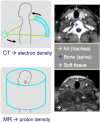The future of hybrid imaging-part 3: PET/MR, small-animal imaging and beyond
- PMID: 22347950
- PMCID: PMC3270262
- DOI: 10.1007/s13244-011-0085-4
The future of hybrid imaging-part 3: PET/MR, small-animal imaging and beyond
Erratum in
-
Erratum to: The future of hybrid imaging-part 3: PET/MR, small-animal imaging and beyond.Insights Imaging. 2012 Apr;3(2):189. doi: 10.1007/s13244-011-0136-x. Insights Imaging. 2012. PMID: 22696045 Free PMC article. No abstract available.
Abstract
Since the 1990s, hybrid imaging by means of software and hardware image fusion alike allows the intrinsic combination of functional and anatomical image information. This review summarises in three parts the state of the art of dual-technique imaging with a focus on clinical applications. We will attempt to highlight selected areas of potential improvement of combined imaging technologies and new applications. In this third part, we discuss briefly the origins of combined positron emission tomography (PET)/magnetic resonance imaging (MRI). Unlike PET/computed tomography (CT), PET/MRI started out from developments in small-animal imaging technology, and, therefore, we add a section on advances in dual- and multi-modality imaging technology for small animals. Finally, we highlight a number of important aspects beyond technology that should be addressed for a sustained future of hybrid imaging. In short, we predict that, within 10 years, we may see all existing multi-modality imaging systems in clinical routine, including PET/MRI. Despite the current lack of clinical evidence, integrated PET/MRI may become particularly important and clinically useful in improved therapy planning for neurodegenerative diseases and subsequent response assessment, as well as in complementary loco-regional oncology imaging. Although desirable, other combinations of imaging systems, such as single-photon emission computed tomography (SPECT)/MRI may be anticipated, but will first need to go through the process of viable clinical prototyping. In the interim, a combination of PET and ultrasound may become available. As exciting as these new possible triple-technique-imaging systems sound, we need to be aware that they have to be technologically feasible, applicable in clinical routine and cost-effective.
Figures






References
LinkOut - more resources
Full Text Sources
Research Materials
